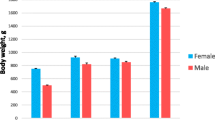Summary
A theoretical model describing the genetic aspect of the transition from traditional to modern animal husbandry is presented. Traditional races are characterized by high tolerance to harsh environments but a low rate of response to increased management inputs. Modern, artificially-selected breeds are efficient convertors of management inputs to higher production but have a low resistance to harsh environments. Thus, under lowinput traditional husbandry, the traditional races are best adapted, while under modern, high-input husbandry, modern breeds are most productive, and in the intermediate zone, hybrids between the two races are capable of closing the ‘profit gap’ in the shift from traditional to modern husbandry. The domesticated European, and the Chinese Big-belly races of the common carp were tested under many environmental ‘treatments’ involving variation in density, polyculture, aeration, feeding and fertilization. The Big-belly showed, as expected, high resistance to the poor ‘treatments’ but low response to environmental improvement. The European breeds performed best in the higher half of the environmental range and their response rates were highest. The F1 hybrids between the two races excelled in the lower third of the range, exhibiting, there, a high heterosis but only an intermediate rate of response. It was concluded that successful changes from one aquaculture system to another, and particularly the change from traditional to modern husbandry, require a simultaneous search for the most efficient genotype × environment combination and, for each level of modernization of traditional fish farming, the most effective genotype must be identified and utilized. The transition from traditional to modern animal husbandry, including fish farming, is best quantified by the levels of invested inputs, other than labour, that induce higher production of the individual animals. The major management inputs of modern fresh water fish farming are expensive feeding, veterinary care, control of predators, organic and chemical fertilizers that enrich the production of natural fish food, water circulation and aeration. Since all these inputs are rather expensive, the fish have to pay for them by increased production, i.e., faster growth rate. Thus, the sina qua non of such a transition is the availability of animal stocks capable of converting increased inputs into economically attractive increased yields. We are all aware of the very great physiological plasticity of farm animals. In the case of the European carp, for example, the same genetic stocks, raised under high stocking density and low feeding level may gain an average weight of 10 to 20 g per fish in a whole year, while under low density and abundant feeding, they may gain over 2 kg in the same period. Such physiological responsiveness may give the wrong impression that all that is needed for the transition to more modern husbandry are improved environmental circumstances. The object of this paper is to point out that the proper choice and changeover of genotypes is equally important for the succesfull implementation of the usually gradual process of fish farming modernization. This demonstration will be based on results of experiments with the European and Chinese races of the common carp, and their F1 hybrids.
Similar content being viewed by others
Literature
Bardach, J.E.; Ryther, J.H.; McLarney, W.O.: Aquaculture. The farming and husbandry of fresh water and marine organisms. New York: J. Wiley 1972
Bucio-Alanis, L.; Perkins, Jean M.; Jinks, J.L.: Environmental and genotype-environmental components of variability. V. Segregating generations. Heredity 24, 115–127 (1969)
Drews, R.A.: Raising fish for food in Southeast Asia. In: Fish as Food (Borgstorm, ed), Vol.I, 121–142. New York: Academic Press, 1961
Knight, R.: The relation between hybrid vigour and genotype-environment interactions. Theor. Appl. Genet. 43, 311–318 (1973)
Mann, H.: Fish cultivation in Europe. In: Fish as Food (Borgstorm, ed), Vol. I, p. 77–102. New York: Academic Press 1961
Moav, R.: Specialised sire and dam lines. I. Economic evaluation of crossbreds. Anim. Prod. 8, 193–202 (1966)
Moav, R.; Wohlfarth, G.: Carp breeding in Israel. In: Agricultural Genetics — selected topics (Moav ed). New York: J. Wiley 1973
Moav, R.; Hulata, G.; Wohlfarth, G.: Genetic differences between the Chinese and European races of the common carp. I. Analysis of genotype-environment interactions for growth rate. Heredity 34, in press (1975)
Wohlfarth, G.; Moav, R.: The effects of variation in spawning time on subsequent relative growth rate and viability in carp. Bamidgeh 22, 42–47 (1970)
Wohlfarth, G.; Moav, R.: The regression of weight gain on initial weight in carp. Aquaculture 1, 7–28 (1972)
Wohlfarth, G.; Moav, R.; Hulata, G.: Genetic differences between the Chinese and European races of the common carp. II. Multicharacter variation — a response to the diverse methods of fish cultivation in Europe and China. Heredity 34, in press (1975)
Author information
Authors and Affiliations
Additional information
Communicated by H. Skjervold
Rights and permissions
About this article
Cite this article
Moav, R., Soller, M. & Hulata, G. Genetic aspects of the transition from traditional to modern fish farming. Theoret. Appl. Genetics 47, 285–290 (1976). https://doi.org/10.1007/BF00281933
Received:
Issue Date:
DOI: https://doi.org/10.1007/BF00281933




